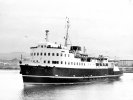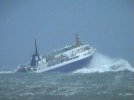It was about 1980, when I was 18, I travelled on my own from Leicester to Douglas IOM to spend a few days riding the railways and trams. The ferry crossing was horrendous and people were being seasick everywhere.
On arrival there were two policeman monitoring passengers as they disembarked the ship. When it was my turn one of the officers took my arm and told me I was being taken into custody and put me in a police car. I was still feeling seasick and too shocked to say anything.
Eventually at the police station I was told that I was being arrested on suspicion of (Northern Irish) terrorism! I was allowed to make one phone call, so I called my mum who then spoke to the officers. I don't know what then happened but after about another hour or two I was told I could go, apparently the police had been tipped off about a terrorist arriving on the ship and I had fitted the description perfectly. Fair enough but I didn't get any apology and no offer of a lift to my B&B or a taxi, I had no idea where the police station was situated either and I was many hours late for my expected arrival there.
My brother had a similar experience at Luton Airport having been mistaken for a german terrorist from the Bader-Meinhof gang.



